History of the Great Allentown Fair
On a wintery day in 1852 with snow blanketing the valley, leading citizens from the far reaches of Lehigh County ventured to the quaint hamlet of Egypt in Whitehall Township for a noble cause. At this momentous gathering, the nonprofit Lehigh County Agricultural Society impassioned to reward the achievements of farmers, gardeners and homemakers, was born. The annual exposition the founders of the Society created, supports agriculture, entertains the public, and has hosted millions of visitors in three centuries.
The Great Allentown Fair, the thrust of the Society’s mission, is ranked one of North America’s Top 50 fairs every year. Its 1852 successful debut on a four-acre tract in Allentown prompted the Society’s purchase of a 14-acre site just blocks north of the city’s downtown. There, harness racing boosted the appeal of the exposition known for showcasing livestock and produce, rides, games, food stands and entertainment from the wonderfully sublime to the hilariously ridiculous.
Outgrowing that location by 1889, the Society made a daring move to 46-acres west of 17th Street between Liberty and Chew streets to begin an era of remarkable contributions to the region’s renown and economic growth. From 1917-1919, the United States Army Ambulance Corps took over the fairgrounds to ready 20,000+ troops for World War I service marking another amazing use of the property.
The Allentown Fairgrounds is home to the Lehigh Valley’s largest trade show facility Agri~Plex, the beloved Fairgrounds Farmers Market, the nostalgic Ritz Barbecue restaurant, the historic Fairgrounds Hotel restaurant, the MainGate Nightclub, and of course, The Great Allentown Fair.
Over the decades, the Society has strived to be a model citizen opening its gates to thoroughfare traffic, emergency parking and disaster relief, while as a private property owner, paying real estate taxes that support its city, county and school district.
The original agricultural mission of the Lehigh County Agricultural Story continues to be filled by the annual operation of The Great Allentown Fair, but the magnitude of the entertainers that appear at the Martin H Ritter Grandstand increase the event’s national recognition.
NOTABLE DATES
1852-1888
January 24, 1852 – Leading farmers and enterprising citizens traveled on horseback and in drawn carriages from the far reaches of the County of Lehigh. They proceeded to the public house of William Leisenring in the village of Egypt, Whitehall Township. There it was resolved, as the culmination of a series of meetings in 1850 and 1851, to form an agricultural society with its aim being “the improvement and advancement of agriculture, horticulture, livestock and the domestic and mechanical arts.” To fulfill this mission, gentlemen representing every municipality in the County were appointed to lead the planning of an exposition. This celebration of the harvest would award the achievements of farmers and homemakers while entertaining the public.
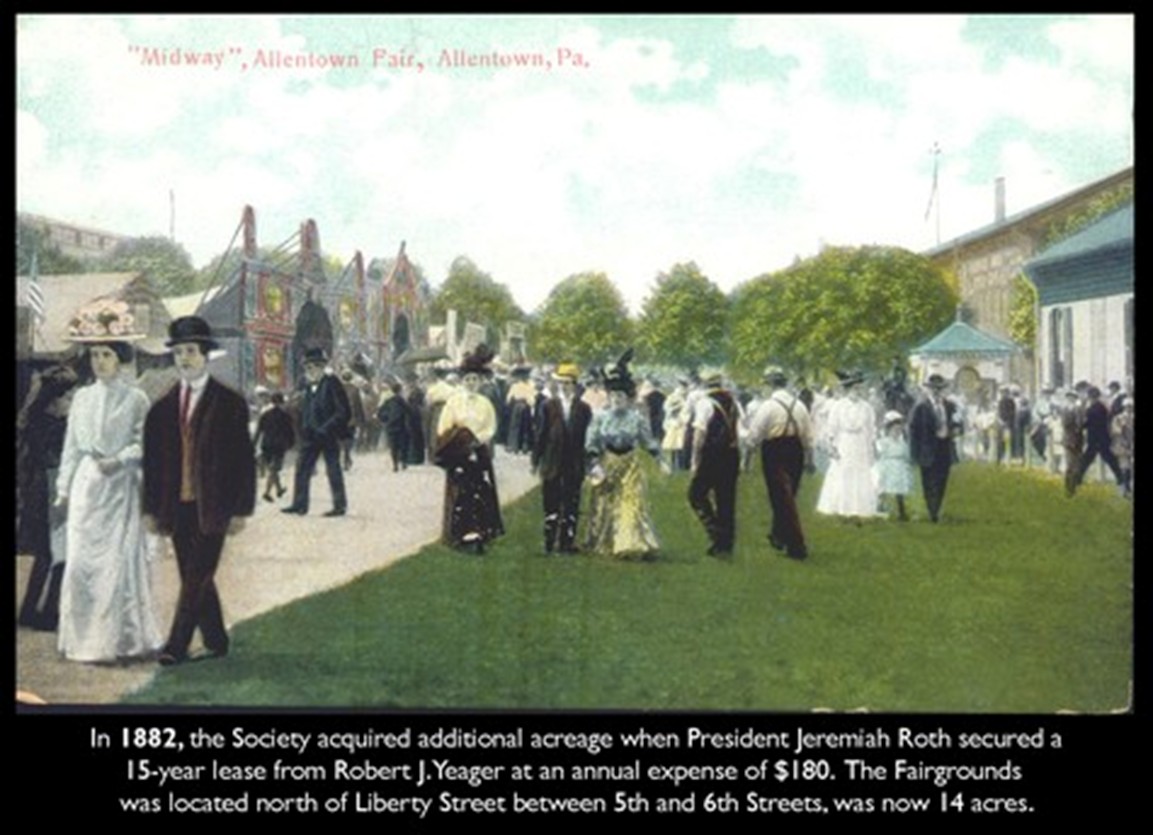
The Allentown Fair was born.
February 2, 1852 – The Lehigh County Commissioners formally recognized and chartered the Lehigh County Agricultural Society. The new Society quickly adopted a constitution and chose Allentown, the county seat with its population of 3,779, as the location for its first Fair.
Edward Kohler, Esq., of North Whitehall, was elected the first president of the Lehigh County Agricultural Society. A noteworthy relationship—Daniel Beisel, the acting president at the January 24, 1852 meeting where definite action was taken to form the Society, was the maternal great-grandfather of current Society President Martin H. Ritter. Daniel’s father George Beisel, Martin Ritter’s great great-grandfather, authored the original draft of the Society’s constitution.
October 6, 7 and 8, 1852 –the first “Lehigh County Agricultural Fair” operated on a five-acre plot east of south Fourth Street, between Walnut and Union streets. Admission into the grounds was 25-cents. The Fair opened at 6 a.m. and closed at 6 p.m.
1889 – 1909
The “Great” Allentown Fair, as it was dubbed in 1889 when it moved from what now is fondly referred to as the Old Fairgrounds to its larger location on 17th and Chew streets, was about to enjoy its most celebrated period of growth and evolution. History would be made on the new half-mile racetrack that was renowned as one of the best in the country for the sulkies and the trotters. Beautiful exhibition buildings did justice to the bounteous displays of agriculture, horticulture, domestics and fine arts.
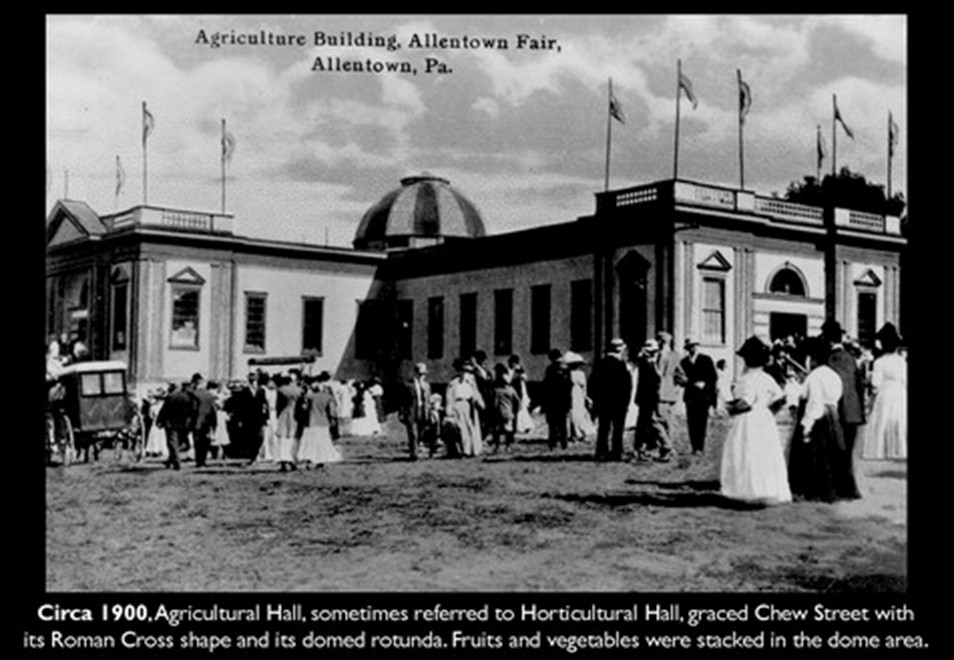
February 5, 1889 – Society officers were authorized to sell the old fairgrounds at public sale to the highest bidder. The sale of the property divided into plots garnered $35,000. The old grounds, known for its chirping blackbirds that inhabited the shade trees, were given over to the expanding Allentown neighborhoods of neatly aligned row and twin homes.
April 4, 1889 – the Society purchased 37 acres from Solomon Griesemer, S. D. Lehr, and Catharine Newhart situated in South Whitehall Township, just west of Allentown’s city limits.
The new Fairgrounds was located on 17th Street between Chew and Liberty streets. It boasted a lush tree-dotted grove on its east side, and had room for a half-mile track, a large grandstand, numerous exhibition buildings and stables the Society desired.
Spring 1889 – work began immediately to ready the new grounds for its first Fair. Many structures were transferred from the old grounds and re-erected on the new, including Mechanics Hall, Floral Hall, the beer stand and the livestock shelters.
1910-1941
The Great Allentown Fair responded to the increased sophistication of its fairgoers introducing night shows and more intriguing exhibits. The nation was evolving from agricultural to industrial. The roaring ‘20s evaporated into the hard times ‘30s, but the Fair retained its popularity throughout the era.
In 1910, the first airplane circled the Allentown Fair when officials engaged pilot Glen Curtis to fly his bi-plane, similar to the Wright machine, daily around the racetrack. In 1914, the Fair featured an airplane show for the first time.
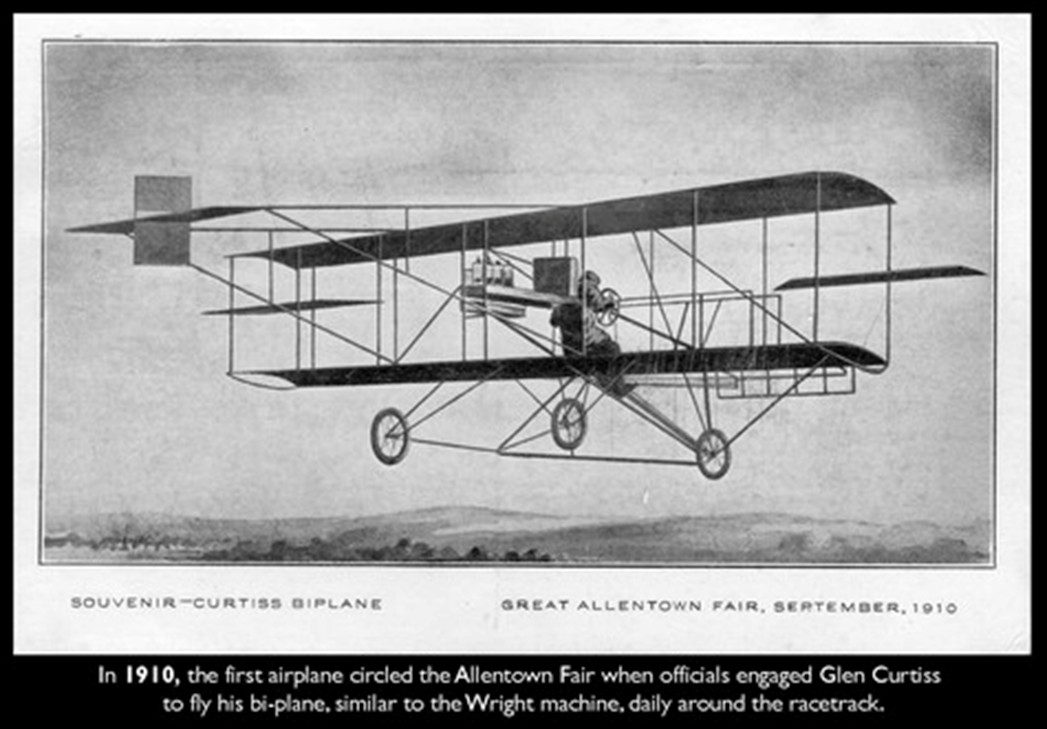
A new steel, brick and concrete Grandstand, an architectural masterpiece, was completed in 1911 as a testament to the Fair’s enormous success. It seated 7,070 spectators. It cost the Society $100,000 to build. The subway under the racetrack, which is the vehicle tunnel entrance off of Liberty Street, was also constructed.
Children were forbidden to attend the 1916 Allentown Fair. Infantile Paralysis (Polio) epidemic took its toll on the population and the festivities at the Fair.
Big Thursday, an annual phenomenon at the Fair when everyone visited, hit a high mark of 80,000 fairgoers in 1918.
World War I strongly impacted the Great Allentown Fair. On May 28, 1917, the Secretary of War approved and signed a lease to use the Allentown Fairgrounds as a training center for the United States Army Ambulance Service.
1942-1963
America was fighting a World War on two fronts while the Lehigh County Agricultural Society continued to hold its Great Allentown Fairs brimming with patriotic themes and contributions to the nation’s effort. Soldiers enlisted and were honored on the fairgrounds, night shows gushed red, white and blue, and demonstrations of how to ration and plant Victory Gardens abounded. After the war ended, one of its most decorated generals received a hero’s welcome at “America’s Greatest County Fair.” Families went from gathering around the radio to television, and their desire to see in person the big name stars that were beamed into their living rooms prompted the Allentown Fair into becoming a trendsetter in the fair industry.
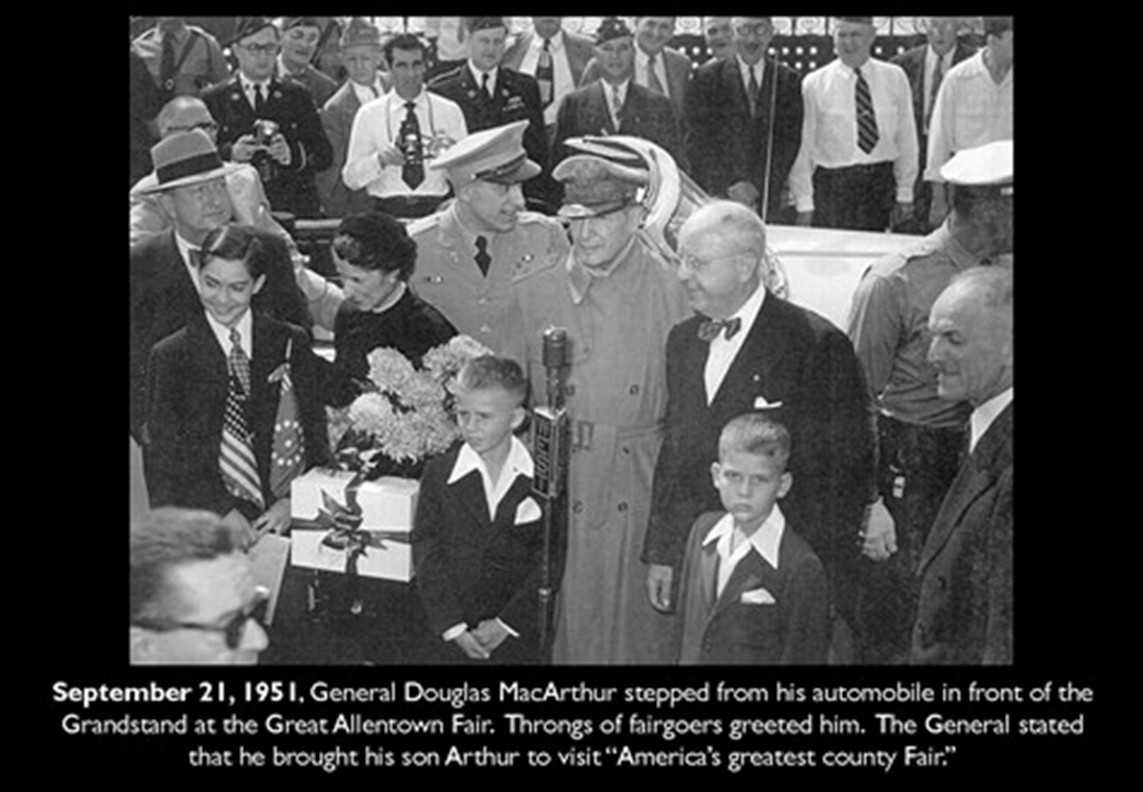
Fair admission, which had fallen back to 25-cents during the Depression, went back up to 50-cents in 1942.
World War II loomed heavily on the minds of fairgoers in 1942. While federal officials suggested county fairs suspend to ration gas and rubber, fair officials saw possibilities for the county gatherings to be productive to the war effort.
The Future Farmers exhibit at the 1942 Allentown Fair carried the theme “Future Farmers Grow Potatoes for Victory.” It was one example of how the agricultural clubs promoted the planting of Victory Gardens.
Big Thursday 1942 – 122 men were sworn into the United States Navy and marched into the Grandstand as new recruits. A War Stamp and Bond Drive was the joint effort of The Great Allentown Fair and local radio station WSAN in 1942. The showgirls from George Hamid’s revue assisted in the campaign raising over $5,000.
1964-1977
The original, agricultural mission of the Lehigh County Agricultural Story continued to be filled by the annual operation of The Great Allentown Fair, but the magnitude of the entertainers that appeared at the Grandstand increased the event’s national recognition. No other fair could boast a more impressive bill of stars. Fair dates changed from harvest time during the third week in September to an early August slot enabling television entertainers to appear before their taping season and offering night show crowds warmer temperatures.
The Grandstand was dubbed the Home of the Stars and mightily lived up to its reputation.

For most of the 1960s – show tickets sold for $2, $3 and $3.50 in the covered grandstand 100 feet away from the stage and track seats right in front of the stage sold for $5.
Television variety show hosts made the biggest splashes. Andy Williams crooned “Moon River” to ecstatic audiences in 1964 and he brought the Osmond Brothers back for their second Fair appearance, this time introducing a fifth member of the performing family, five-year-old Donny.
Big names performing in the ‘60s included Lawrence Welk 1961, 62, 69, popular piano virtuoso Liberace 1965, 68, Donald O’Connor 1965, Danny Kaye 1965, Perry Como 1966, trumpeter Al Hirt 1968, Eddy Arnold 1968, “Laugh-In’s” Rowan & Martin 1968, Merv Griffin 1969, Johnny Cash 1969, John Davidson 1969, and many more.
Star of the “Tonight Show” Johnny Carson made an unprecedented Fair appearance in 1967. He brought along sidekick Ed McMahon, who had been at the 1954 Fair when he was touted “Clown of the Big Top” on Philadelphia’s WCAU Channel 10. Singer Kaye Stevens joined Johnny as did a teenage banjo-picking Roy Clark, who after being with Johnny at the Fair, mentioned it every time he appeared on the Tonight Show over the next three decades.
1978-1989
Summer thunderstorms and oppressive August heat made Fair officials long for their old September Fair. It did not seem likely that County school districts would return to giving time off for Fair attendance, so the decision was reached to operate the Fair during the days leading up to and through the Labor Day holiday weekend. All of the factors that had affected the nation’s economy in the late 1970s – inflation, recession, fuel shortages – had taken a toll on the Fair. The Committee worked to cope with rising costs of operating the annual event and maintaining the Fairgrounds. It strived to anticipate the community’s rapidly evolving tastes in entertainment. Running a fair was no longer a simple business of handshakes. The Lehigh County Agricultural Society pulled together to keep its Fair viable and relevant.
August 25-September 2, 1978 – the Fair coincided with the Labor Day holiday for the first time. Because of the time change, Goodings Million Dollar Midway could not provide enough attractions. The Society tried several carnival companies over the next few years to suitably fill the lot.
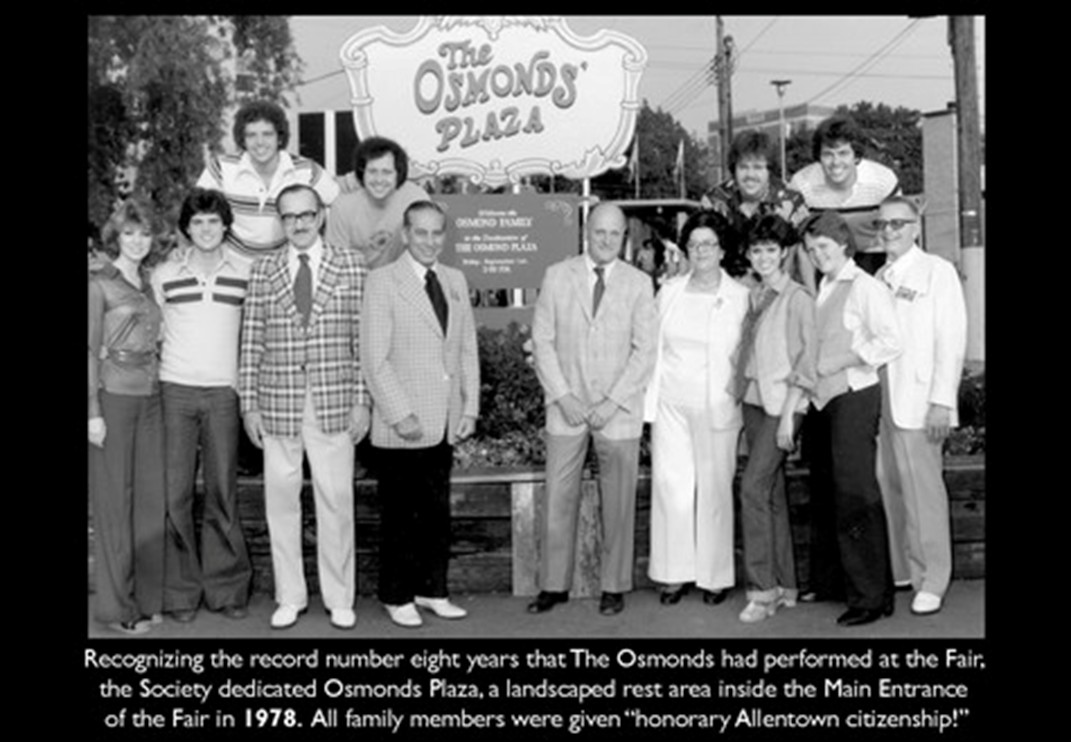
Recognizing the record number eight years that The Osmonds had performed at the Fair, the Society dedicated Osmonds Plaza, a landscaped rest area inside the Main Entrance of the Fair in 1978. All family members were given “honorary Allentown citizenship!”
Notable headliners that took the Fair from the ‘70s into the ‘80s and beyond included Chicago 1978, 87, 90, Barbara Mandrell 1979, 82, 84, 90, Sha Na Na 1979-81, The Beach Boys 1979, 82, 83, 86, 87, 92, 94, Anne Murray 1979, and Loretta Lynn 1981, 87.
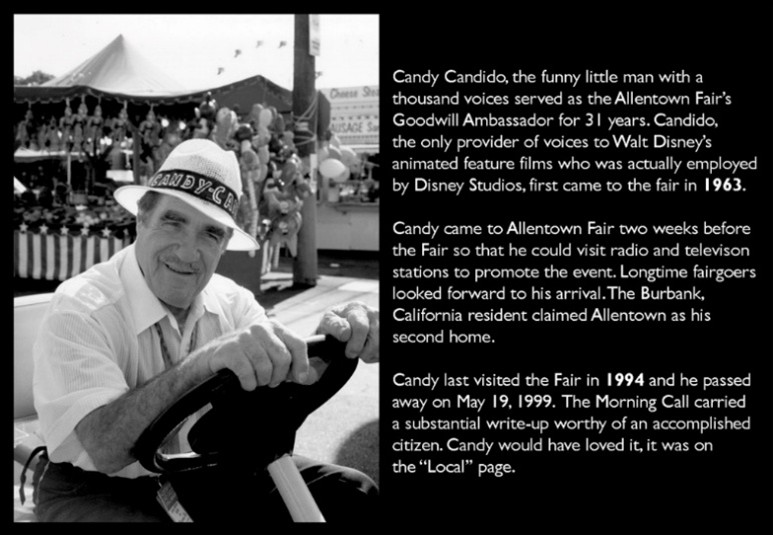
1990-2001
A string of successful expositions solidly positioned the Society to take its Fair into the new Millennium. A major disaster nearly destroyed a Fairgrounds landmark, the famous Ritz Barbecue, but area firefighters and a reconstruction company came to the rescue. Boy bands became popular again and the Fair’s Grandstand was filled with screaming teens like it was during Osmond Mania two decades earlier. Country music superstars made a big statement, too. Recognizing that the consuming public wanted to know how its food gets from the farm to the table, the Lehigh County Agricultural Society went back to its original mission.
The 1990s opened with more big names in the Grandstand such as Kenny G and Michael Bolton 1990,
The Judds 1991, Randy Travis 1991, James Taylor 1992 and a trio of Sharon, Lois and Bram, children’s performers who sold out the Grandstand to wee folks requiring the first stroller parking lot! 1990, 91
Grandstand stage production sets were getting bigger every year. In 1992, the roof could no longer hold the extensive lighting and suspended speakers many stars required, so the Society decided to give it a lift. The Alvin H. Butz Company reconstructed and raised it.
Reba McEntire posted back-to-back Labor Day sellouts in the Grandstand. The redheaded country superstar is one of the Fair’s most enduring and endearing performers 1991, 94, 95, 99.
All the rage, teen acts The Backstreet Boys 1998, Britney Spears 1999, 98º 1997, 99, 01, LFO 2000, and Destiny’s Child 2000 brought back the fan hysteria that greeted The Osmonds in the 1970s.

Country music performers proved they have the most ardent fans when the Fair hosted overnight campers waiting for tickets to go on sale several times in the last decade. Major artists included Randy Travis 1992, 98, Clint Black 1993, Wynonna 1993, 96, Vince Gill 1994, 97, Alan Jackson 1994, 95, 98, 2000, Tim McGraw 1999, Faith Hill 1994, 95, and Brooks & Dunn 1995, 95, 99, 2001.

June 14, 1998 – The house that Billy Ritz built, the famous Ritz Barbecue that had stood as a Fairgrounds landmark 60 years and held countless memories for the “greasers” of the ‘50s who made it their hangout and their offspring who reveled in its nostalgia, burned in a three-alarm blaze. The tremendous effort by the Allentown Fire Department, the commitment of proprietor Jeff Skinner to rebuild, and the round-the-clock exertion by The Alvin H. Butz Company allowed the Ritz to miraculously reopen in time for the 1998 Fair.
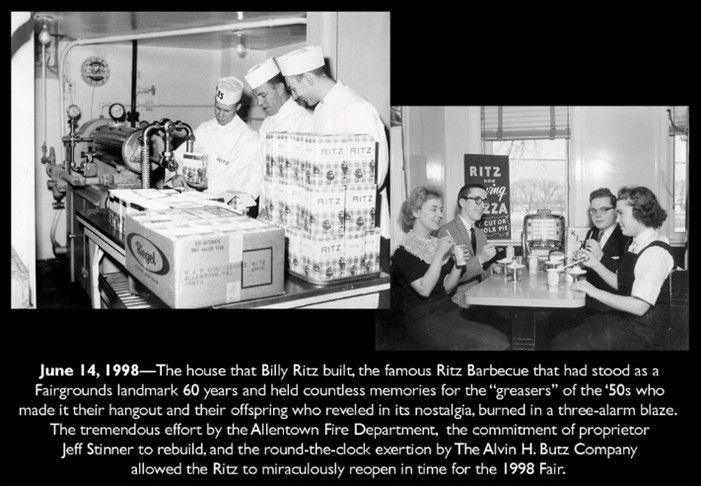
Show-band leader Bobby Mercer, who has become a staple of the Fairs during the last decade, enlarged his orchestra for “100 Years of American Music,” a tribute show and dance that closed the 1999 Fair and a complete Century in which the Society existed.
The Fair that originally was a gathering of farmers to celebrate the harvest and share technologies was rededicated to providing education to a non-agrarian public. Guided tours of animal exhibits, free farm fun activities, “You Be the Judge” follow-along sheets, information signs about the species, and encouragement to the public to talk to the exhibitors about food production were implemented into the Fair program.
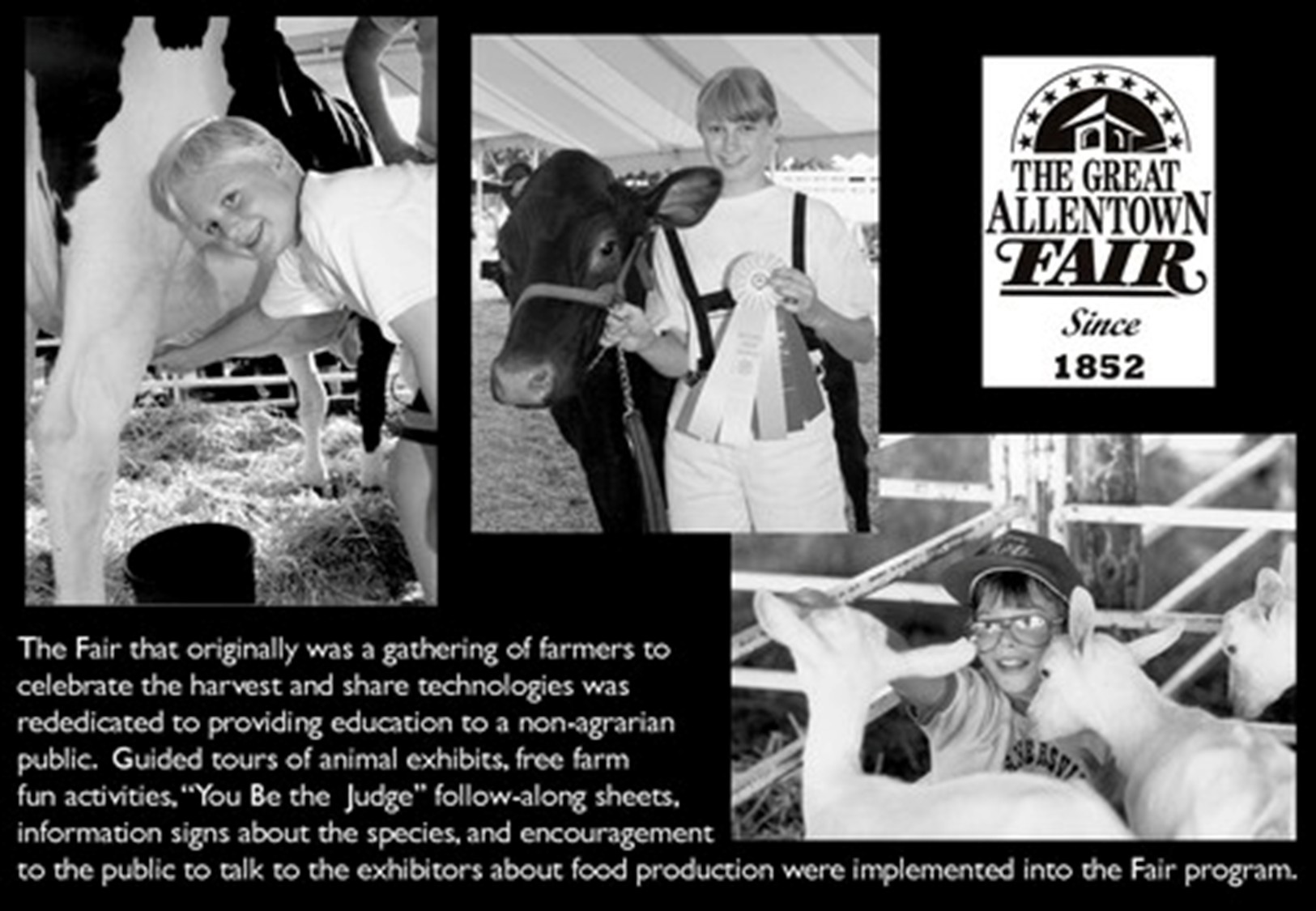
2002-2012
Honoring 150 Years of Tradition
In 2002, the Lehigh County Agricultural Society (LCAS) marked a truly historic milestone—celebrating the 150th anniversary of both its founding and the very first Allentown Fair. The community came together in a spirit of pride and nostalgia for a year filled with commemorative events, engaging exhibits, special entertainment, and the release of a keepsake souvenir cookbook.
A highlight of the anniversary year was the Military Appreciation Weekend in May, which welcomed an estimated 10,000 attendees. The weekend featured a poignant Camp Crane remembrance ceremony, a public forum on re-employment rights for reservists, and an inspiring performance by an 80-piece band inside the William T. Harris Agricultural Hall.
Adding to the excitement, 2002 also set a new record for Fair participation—with over 10,600 entries proudly displayed, it was a year to remember in every way.
A Cool New Era in Agriculture
The 151st Fair in 2003 marked a major milestone with the expansion of the William T. Harris Agricultural Hall. A 17,552 square-foot addition was unveiled, making history as the first time guests could enjoy agricultural exhibits in air-conditioned comfort. This modernized space was renamed the Agri~Plex, reflecting its evolving role as both a premier exhibition hall and a flexible venue for year-round events.
This upgrade wasn’t just about comfort—it represented a bold step forward in blending tradition with innovation, ensuring that agriculture remained at the heart of the Fair experience.
Celebrating Legacy and Record Crowds
In 2004, the Fair paid tribute to one of its most influential figures—Martin H. Ritter—by naming the Grandstand in his honor. A bronze plaque bearing his likeness was unveiled in a heartfelt ceremony, recognizing his enduring impact on the Fair’s legacy.
The newly upgraded Agri~Plex continued to shine, with the Centennial Stage expanding its entertainment lineup to delight audiences of all ages. Meanwhile, beautiful weather helped draw record-setting crowds across the seven-day event.
The Grandstand rocked with unforgettable performances from major acts like Kenny Chesney, Lynyrd Skynyrd, and ZZ Top, each playing to packed audiences. Adding to the excitement, Governor Ed Rendell attended the ribbon-cutting ceremony for a new garden addition at Pepsi Plaza, bringing an extra touch of charm to the Fairgrounds.
A Year of Magic and Milestones
In 2005, the Fair embraced innovation and excitement with the introduction of new youth categories in the Agri~Plex. For the first time, young participants ages 2 to 19 had the opportunity to showcase their talents and compete for coveted blue ribbons—adding fresh energy and enthusiasm to the competition.
That same year, Opening Ceremonies delivered a truly unforgettable moment. Before a captivated audience, a 1,600-pound Holstein named Moodini mysteriously vanished in a dazzling display of illusion, kicking off the Fair with the fitting theme: “Experience the Magic.” It was a celebration of wonder, community, and new traditions that would continue to grow for years to come.
The Fair Youth Group also celebrated 20 years of community involvement, and S&S Amusements earned the prestigious Circle of Excellence award from the Outdoor Amusement Business Association.
Storms, Sand, and Sweet Farewells
The 2006 Fair embraced a vibrant tropical theme—“FAIR-adise”—but Mother Nature had other plans. A surprise tropical storm rolled in, impacting both the weather and attendance. Still, the spirit of the Fair endured, and one of the year’s biggest highlights was a breathtaking 50-ton sand sculpture, which stood strong as a central attraction despite the stormy skies.

After 24 years, S&S Amusements took its final spin on the midway. After 24 memorable years, the beloved carnival partner bid farewell, closing a significant chapter in the Fair’s entertainment legacy.
Emphasizing the “55” in its 155th anniversary, the Fair embraced a nostalgic “Oldie But Goodie” theme that paid tribute to its long history.
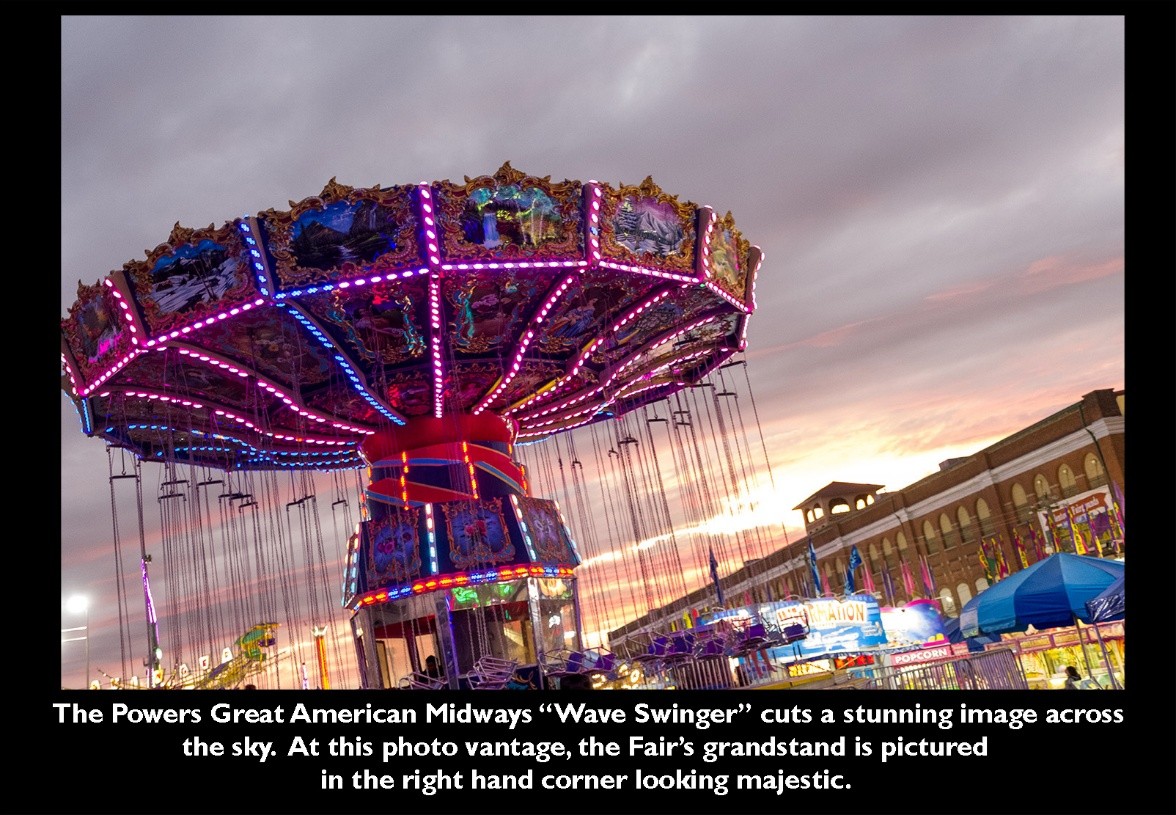
Fresh Thrills and Flavorful Traditions
In 2008, the Fair welcomed a brand-new carnival partner as Powers Great American Midways made its debut. With an exciting mix of rides, games, and food stands, the midway came alive with fresh energy and became an instant crowd-pleaser.
The Fair’s beloved culinary contests, which had started as a fun tradition two decades earlier, continued to grow in popularity. This year, the excitement spilled over onto an expanded stage with the introduction of live cooking demonstrations—entertaining and engaging food lovers of all ages.
Behind the scenes, the spirit of community shone brightly as MunOpCo expanded its volunteer presence at the entrance gates, helping ensure a warm welcome and smooth experience for Fairgoers from start to finish.
By 2009, the Fair revived the Fair Queen competition, which had ended in 1990. The new Fair Queen was tasked with promoting the Fair’s agricultural mission and acting as its goodwill ambassador.
Going Digital and Giving Back
The 2010 Fair marked the start of a new chapter in connectivity and communication, as the Fair officially joined Facebook, stepping into the digital age and opening up new ways to engage with fans and the community year-round.
That same year, the Lehigh County Agricultural Society proudly hosted the Pennsylvania State Association of County Fairs (PSACF) Zone 4 meeting, welcoming representatives from 29 regional fairs—a true gathering of tradition, innovation, and shared passion for fair culture.
In a moment that highlighted the Fair’s deep ties to the community, the Allentown Fire Department presented the Fair with a Certificate of Appreciation for providing shelter and support to victims of a devastating gas explosion. It was a year defined by progress, partnership, and heartfelt service.
A Century of Memories at the Grandstand
In 2011, the Fairgrounds’ iconic Grandstand celebrated its 100th anniversary, marking a century of unforgettable performances, historic moments, and cherished memories. For 100 years, this beloved venue has been a central hub for entertainment, drawing generations of Fairgoers to witness concerts, shows, and other special events that have become a key part of the Fair’s rich legacy.
This milestone year was a celebration of the Grandstand’s enduring presence and its importance in the community, honoring the many events that have taken place over the past century.
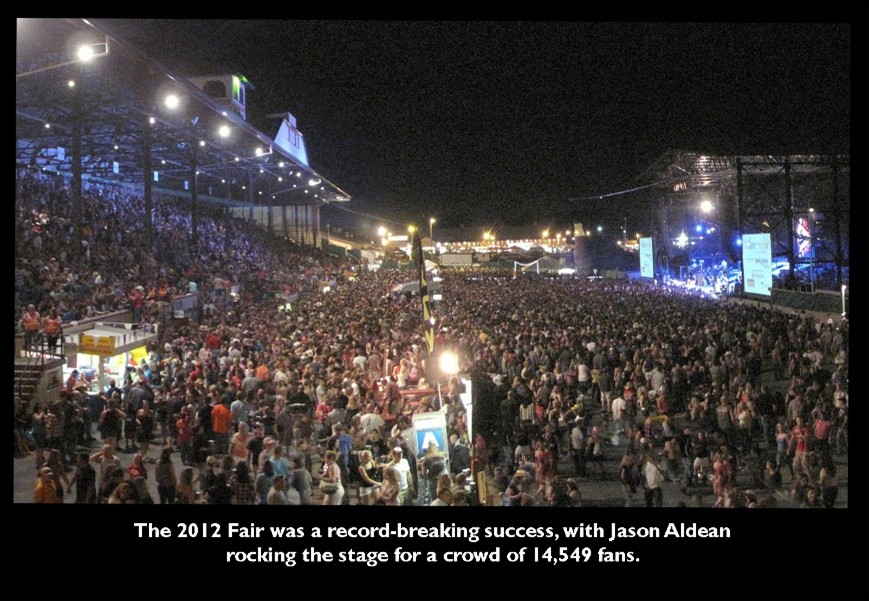
2012-Today
Big Crowds, Bold Changes, and a Record-Breaking Night
The 2012 Fair made headlines and history with a show-stopping performance by Jason Aldean, who rocked the Grandstand in front of a sold-out crowd of 14,549 fans. The concert not only electrified the audience—it also set a new revenue record, grossing an impressive $839,938 and solidifying the Fair’s status as a major entertainment destination.
But 2012 was more than just music—it marked the beginning of a new era in Fair hospitality. That year, the Allentown Fair became one of the first in Pennsylvania to offer beer service at Grandstand concerts, introducing The Grandstand Pub as a new amenity for adult guests. The success of this move laid the groundwork for even more exciting changes in the years that followed.
As the Fair continued to grow and evolve, these updates reflected its commitment to blending tradition with innovation—creating unforgettable experiences for longtime fans and first-time visitors alike.
A Revitalized Fairgrounds and Timeless Touches
In 2014, the Fairgrounds underwent a significant revitalization as part of an ongoing effort to enhance the visitor experience. One of the most notable improvements was the installation of a classic iron fence and elegant lanterns, which brought a timeless charm and sophisticated aesthetic to the entrance.
These updates not only improved the Fair’s appearance but also set the stage for future growth and continued tradition, creating a welcoming atmosphere for all who visited.
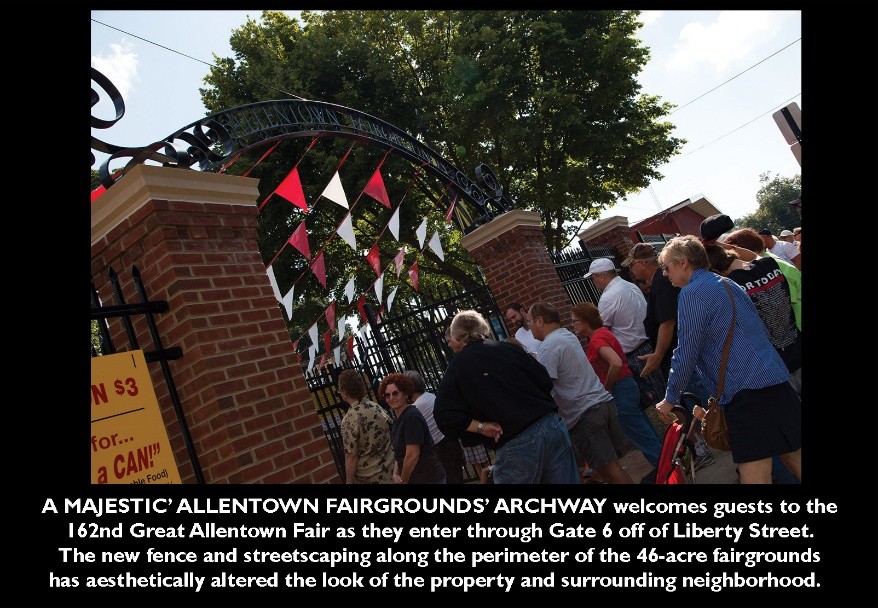
Star-Studded Performances and Strategic Partnerships
2019 saw the Fair bring in high-profile acts like KISS, Chris Stapleton, Meghan Trainor, and Jeff Dunham, drawing massive crowds to the Grandstand and solidifying its place as a premier entertainment destination. That same year, the Fair took a major step forward by forming a multi-year partnership with Live Nation to manage Grandstand entertainment, ensuring top-tier acts for years to come.
In another strategic move, the Fair took over the distribution of bottled water and soft drinks, a shift that proved not only efficient but also highly profitable, enhancing the overall experience for guests.
Adapting to Challenges with Community Spirit
In 2020, the Fair faced an unprecedented challenge as the COVID-19 pandemic led to its cancellation. However, in the spirit of community and resilience, the Fair introduced a creative alternative—“Feast the Fair”, a drive-thru event that allowed fans to enjoy their favorite fair foods safely from the comfort of their cars. This innovative solution helped maintain the Fair’s tradition of bringing people together, even in the midst of uncertain times, while adhering to health and safety guidelines.
A Safe Return with New Precautions and Community Support
In 2021, the Fair made its highly anticipated return, albeit with a reduced schedule of 6 nights and 5 days, reflecting the ongoing pandemic challenges. To ensure the safety of all attendees, new security measures, including metal detectors, were introduced as part of the Fair’s commitment to a secure environment for everyone.
The Fair also embraced email communication to keep stakeholders informed and connected in a more efficient and timely manner. Additionally, in a show of community support, the Fair hosted a COVID-19 vaccination clinic at the Agri~Plex, helping local residents stay safe while continuing to enjoy the Fair’s festivities.
Expanding Partnerships and Cultivating Education
In 2022, the Fair took a significant step in enhancing its Grandstand entertainment by signing a three-year contract with Kentucky-based Triangle Talent to handle concert bookings. This partnership ensured top-tier performances and exciting entertainment for years to come.
The Fair also launched Ag Education Day, an annual event held each October. This initiative invited Allentown School District fourth-grade classes to the Fairgrounds to learn about the crucial role agriculture plays in our world—sparking curiosity and fostering a deeper understanding of farming and food production among the next generation.
Innovation and Advocacy at the Fair
In 2023, the Fair introduced an exciting new element with the debut of a commercial brewery competition, adding a unique flair to its culinary offerings and celebrating the growing craft beer scene.
That same year, the Fair made history by becoming the first fair to host a listening session for the Agriculture Committee’s Farm Bill, led by Chairman G.T. Thompson. This session provided a platform for agricultural leaders and stakeholders to discuss important policies, underscoring the Fair’s ongoing commitment to supporting the farming community and advocating for its future.
New Attractions, Digital Engagement, and Community Impact
In 2024, the Fair introduced The Society Insider, a digital quarterly newsletter designed to keep the community informed and engaged with all things related to the Fair. This new initiative allowed for deeper connection and communication with Fairgoers.
The year also brought fresh excitement with the addition of balloon displays and a scrapple-eating contest, adding unique attractions to an already vibrant event lineup.

A major milestone for community outreach occurred when the Pennsylvania House of Representatives Agricultural and Rural Affairs Committee held its first-ever meeting at a fairgrounds on opening day. This historic session, focused on the impact of fairs in Pennsylvania, highlighted the Fair’s role as a key player in shaping agricultural policy and fostering dialogue on vital issues.
Additionally, Powers & Thomas Midway Entertainment took over carnival operations, continuing the tradition of delivering top-tier rides and entertainment to Fairgoers.
Through constant adaptation, infrastructure improvements, expanded educational programs, and exciting new attractions, the Fair has solidified its place as a cherished community event, deeply rooted in tradition while looking to the future.
The Great Allentown Fair stays relevant because at its roots is the sustenance of life that never goes out of style—agriculture.
HOME OF THE STARS
Experience the Magic of the Grandstand Stage at The Great Allentown Fair! Over the years, the Grandstand Stage has been the heartbeat of entertainment at The Great Allentown Fair—featuring unforgettable performances from legendary artists, rising starts, and thrilling live shows. From country legends to rock icons, family-friendly acts to high-energy performances, the Grandstand has hosted a diverse lineup of talent that captivates fairgoers year after year.
For many, the Grandstand Stage is more than just a venue—it’s a first concert experience. It’s the spot where memories are made, where first notes and first cheers become unforgettable milestones. Whether you’re attending your very first show or creating cherished memories with family and friends, the Grandstand Stage sets the stage for magical moments. CLICK HERE to check out the incredible lineup of artists that have performed on the Grandstand’s Historic Stage.
